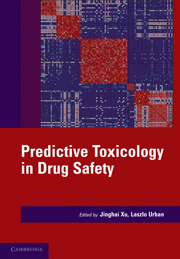Book contents
- Frontmatter
- Contents
- Contributors
- Prologue – Predictive toxicology: a new chapter in drug safety evaluation
- PREDICTIVE TOXICOLOGY IN DRUG SAFETY
- I SPECIFIC AREAS OF PREDICTIVE TOXICOLOGY
- 1 The human predictive value of combined animal toxicity testing: current state and emerging approaches
- 2 Screening approaches for genetic toxicity
- 3 Cardiac safety
- 4 Predicting drug-induced liver injury: safer patients or safer drugs?
- 5 In vitro evaluation of metabolic drug–drug interactions
- 6 Reliability of reactive metabolite and covalent binding assessments in prediction of idiosyncratic drug toxicity
- 7 Immunotoxicity: technologies for predicting immune stimulation, a focus on nucleic acids and haptens
- 8 Predictive models for neurotoxicity assessment
- 9 De-risking developmental toxicity-mediated drug attrition in the pharmaceutical industry
- II INTEGRATED APPROACHES OF PREDICTIVE TOXICOLOGY
- Epilogue
- Index
- Plate section
- References
7 - Immunotoxicity: technologies for predicting immune stimulation, a focus on nucleic acids and haptens
from I - SPECIFIC AREAS OF PREDICTIVE TOXICOLOGY
Published online by Cambridge University Press: 06 December 2010
- Frontmatter
- Contents
- Contributors
- Prologue – Predictive toxicology: a new chapter in drug safety evaluation
- PREDICTIVE TOXICOLOGY IN DRUG SAFETY
- I SPECIFIC AREAS OF PREDICTIVE TOXICOLOGY
- 1 The human predictive value of combined animal toxicity testing: current state and emerging approaches
- 2 Screening approaches for genetic toxicity
- 3 Cardiac safety
- 4 Predicting drug-induced liver injury: safer patients or safer drugs?
- 5 In vitro evaluation of metabolic drug–drug interactions
- 6 Reliability of reactive metabolite and covalent binding assessments in prediction of idiosyncratic drug toxicity
- 7 Immunotoxicity: technologies for predicting immune stimulation, a focus on nucleic acids and haptens
- 8 Predictive models for neurotoxicity assessment
- 9 De-risking developmental toxicity-mediated drug attrition in the pharmaceutical industry
- II INTEGRATED APPROACHES OF PREDICTIVE TOXICOLOGY
- Epilogue
- Index
- Plate section
- References
Summary
ADVERSE DRUG REACTIONS MEDIATED BY THE ADAPTIVE IMMUNE SYSTEM
The adaptive immune system is responsible for the occurrence of drug allergies after applying certain chemicals for example to the skin. Symptoms of such allergic hypersensitivities are observed only in the elicitation phase and not in the preceding sensitization phase, as only the second exposure to the causative drug results in T cell- or antibody-mediated adverse effects.
In 1935, Karl Landsteiner introduced for the first time low molecular reactive chemicals as haptens, which after covalent coupling to proteins induce hapten-specific antibodies, or stimulate specific T cell responses. Hapten recognition by T cells requires covalent attachment of the hapten to major histocompatibility complex (MHC)-associated peptides on antigen-presenting cells (APCs), for example with trinitrophenyl (TNP). However, nonreactive drugs also can result in T and B cell-mediated allergic hyperreactivities. Such so-called prohaptens upon cellular metabolism are transformed into reactive metabolites that are able to bind to MHC-binding self peptides. One of the best studied examples for prohaptens is urushiol from the North American poison ivy. In addition to haptens and prohaptens, transition metals such as chromium, beryllium, or nickel are important contact allergens in the industrialized world. In rare cases, topical antibiotics such as beta-lactams can result in allergic contact dermatitis, a well-documented side effect of such antibiotics (e.g., penicillin). In addition, animal or plant proteins as well may induce allergic skin reactions and contact hypersensitivities.
- Type
- Chapter
- Information
- Predictive Toxicology in Drug Safety , pp. 124 - 134Publisher: Cambridge University PressPrint publication year: 2010



